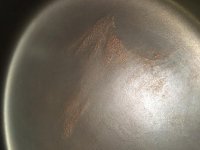It's not pitting because pitting removes metal and these are raised surfaces. Pretty weird, what could have caused this? A casting flaw, maybe? It's a shame I picked up two griswold #5s, ones a spinner and this one has this going on...here's a pic after the first seasoning.
-
If a web search for the answer to your cast iron cookware question has brought you directly to this forum, the information you seek may be covered in one of the many reference topics featured on the main website.
Quick Links: · Main Website · How to Identify Unmarked Pans · All About Cleaning & Seasoning · Reproductions & Counterfeits · Commonly-Used Terms
You are using an out of date browser. It may not display this or other websites correctly.
You should upgrade or use an alternative browser.
You should upgrade or use an alternative browser.
What kind of damage is this?
- Thread starter JakeN.
- Start date
W. Hilditch
Active member
If that is the outside bottom that could be the result of one of those smooth top stoves as the top experienced meltdown. If the cooking surface, a contaminant may have been in the iron. In either case I’d hit it with fine sandpaper and smooth it out.
Hilditch
Hilditch
I have a couple theory's as to what may of caused those raised areas but could be completely off base.
From the picture you provided it looks to me like someone possibly had it setting on the floor of a metal fabrication shop and someone using a cutting torch was letting the cuttings fall into the skillet....or a person using a electric grinder was letting the sparks from their work fall into the skillet. In either case the sparks from each of those procedures would be hot enough to adhere to the surface of the skillet and if not cleaned immediately probably built up the surface which you currently have....just a theory.
My question is why have you done a seasoning process on it knowing that there was a raised surface which was not normal? Second question; Have you tried running it thru an electrolysis session to see if it may remove the raised areas?
From the picture you provided it looks to me like someone possibly had it setting on the floor of a metal fabrication shop and someone using a cutting torch was letting the cuttings fall into the skillet....or a person using a electric grinder was letting the sparks from their work fall into the skillet. In either case the sparks from each of those procedures would be hot enough to adhere to the surface of the skillet and if not cleaned immediately probably built up the surface which you currently have....just a theory.
My question is why have you done a seasoning process on it knowing that there was a raised surface which was not normal? Second question; Have you tried running it thru an electrolysis session to see if it may remove the raised areas?
Well I seasoned it because I didn't know what else to do. That is on the cooking surface. And there's actually another small spot on the bottom of the pan. It was in the e tank for a couple days. I never thought of sanding it down I just figured I'd have to deal with it until I found a better one. Interesting theory with the sparks as it does look like a bunch of straight lines, though I've never heard of the sparks actually being able to mess with metal.
I only recommend sanding when a piece is pretty much worthless due to damage or pitting. If it were something like a Wapak Indian Head or some other prized piece I'd be inclined to leave it be, hold onto it, and hope for a better method to be discovered. If you do decide to sand, do it by hand and you'll be less likely to leave grooves, gouges, swirl marks, and other obvious signs that it was sanded. The marks on your pan don't look very thick. I'd try wet sanding with 80 or 100 grit silicon carbide sandpaper and a small block of wood. Use a small amount of water so a slurry forms. Just enough to keep the surface good and wet. It will minimize the risk of leaving swirl marks. The area you sand will be so shiny it'll look like stainless steel when you're done. Unfortunately it will remain shiny even after manual seasoning. Maybe after sanding you could try dropping it in the e-tank overnight. That should darken it back up although I haven't tried it since I've only ever sanded one piece.
After looking at it yesterday and today my first thought was it may of been a splash of a chemical spill of some kind when you look at the angle. What kind and how long who knows? A type of acid could get it to bubble up some and change the surface.
Hard to tell without it in hand. I might just try and sand it down but keep from going just in one direction.
Hard to tell without it in hand. I might just try and sand it down but keep from going just in one direction.
W. Hilditch
Active member
“In either case I’d hit it with fine sandpaper and smooth it out.” Fine = 120 - 220 grit. You can always change to a more course or smoother grit after 15 seconds. Yes I have sanded cast iron. Put a lid on your anxieties and just do it!
Hilditch
Hilditch

